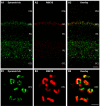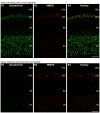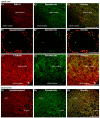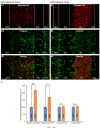The Calcineurin-Binding, Activity-Dependent Splice Variant Dynamin1xb Is Highly Enriched in Synapses in Various Regions of the Central Nervous System
- PMID: 28790889
- PMCID: PMC5524891
- DOI: 10.3389/fnmol.2017.00230
The Calcineurin-Binding, Activity-Dependent Splice Variant Dynamin1xb Is Highly Enriched in Synapses in Various Regions of the Central Nervous System
Abstract
In the present study, we generated and characterized a splice site-specific monoclonal antibody that selectively detects the calcineurin-binding dynamin1 splice variant dynamin1xb. Calcineurin is a Ca2+-regulated phosphatase that enhances dynamin1 activity and is an important Ca2+-sensing mediator of homeostatic synaptic plasticity in neurons. Using this dynamin1xb-specific antibody, we found dynamin1xb highly enriched in synapses of all analyzed brain regions. In photoreceptor ribbon synapses, dynamin1xb was enriched in close vicinity to the synaptic ribbon in a manner indicative of a peri-active zone immunolabeling. Interestingly, in dark-adapted mice we observed an enhanced and selective enrichment of dynamin1xb in both synaptic layers of the retina in comparison to light-adapted mice. This could be due to an illumination-dependent recruitment of dynamin1xb to retinal synapses and/or due to a darkness-induced increase of dynamin1xb biosynthesis. These latter findings indicate that dynamin1xb is part of a versatile and highly adjustable, activity-regulated endocytic synaptic machinery.
Keywords: calcineurin; darkness-induced synaptic recruitment of dynamin1xb; dynamin1xb; retina; splice variant; synapse.
Figures









Similar articles
-
A local, periactive zone endocytic machinery at photoreceptor synapses in close vicinity to synaptic ribbons.J Neurosci. 2013 Jun 19;33(25):10278-300. doi: 10.1523/JNEUROSCI.5048-12.2013. J Neurosci. 2013. PMID: 23785143 Free PMC article.
-
A Multiple Piccolino-RIBEYE Interaction Supports Plate-Shaped Synaptic Ribbons in Retinal Neurons.J Neurosci. 2019 Apr 3;39(14):2606-2619. doi: 10.1523/JNEUROSCI.2038-18.2019. Epub 2019 Jan 29. J Neurosci. 2019. PMID: 30696732 Free PMC article.
-
Spatiotemporal regulation of ATP and Ca2+ dynamics in vertebrate rod and cone ribbon synapses.Mol Vis. 2007 Jun 15;13:887-919. Mol Vis. 2007. PMID: 17653034 Free PMC article.
-
Plasticity of retinal ribbon synapses.Microsc Res Tech. 1996 Dec 15;35(6):472-87. doi: 10.1002/(SICI)1097-0029(19961215)35:6<472::AID-JEMT6>3.0.CO;2-K. Microsc Res Tech. 1996. PMID: 9016450 Review.
-
Presynaptic proteins of ribbon synapses in the retina.Microsc Res Tech. 2000 Jul 15;50(2):141-50. doi: 10.1002/1097-0029(20000715)50:2<141::AID-JEMT6>3.0.CO;2-B. Microsc Res Tech. 2000. PMID: 10891878 Review.
Cited by
-
Synaptic ribbons foster active zone stability and illumination-dependent active zone enrichment of RIM2 and Cav1.4 in photoreceptor synapses.Sci Rep. 2020 Apr 6;10(1):5957. doi: 10.1038/s41598-020-62734-0. Sci Rep. 2020. PMID: 32249787 Free PMC article.
-
Early Changes in Exo- and Endocytosis in the EAE Mouse Model of Multiple Sclerosis Correlate with Decreased Synaptic Ribbon Size and Reduced Ribbon-Associated Vesicle Pools in Rod Photoreceptor Synapses.Int J Mol Sci. 2021 Oct 6;22(19):10789. doi: 10.3390/ijms221910789. Int J Mol Sci. 2021. PMID: 34639129 Free PMC article.
-
Rabconnectin-3α/DMXL2 Is Locally Enriched at the Synaptic Ribbon of Rod Photoreceptor Synapses.Cells. 2023 Jun 19;12(12):1665. doi: 10.3390/cells12121665. Cells. 2023. PMID: 37371135 Free PMC article.
-
Early auto-immune targeting of photoreceptor ribbon synapses in mouse models of multiple sclerosis.EMBO Mol Med. 2018 Nov;10(11):e8926. doi: 10.15252/emmm.201808926. EMBO Mol Med. 2018. PMID: 30266776 Free PMC article.
-
Ciliary Proteins Repurposed by the Synaptic Ribbon: Trafficking Myristoylated Proteins at Rod Photoreceptor Synapses.Int J Mol Sci. 2022 Jun 27;23(13):7135. doi: 10.3390/ijms23137135. Int J Mol Sci. 2022. PMID: 35806143 Free PMC article.
References
LinkOut - more resources
Full Text Sources
Other Literature Sources
Miscellaneous

